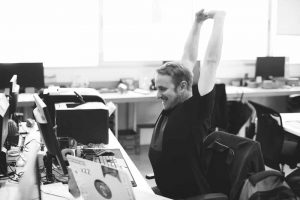An Emerging Athlete often strives to achieve higher productivity and to reach his set goals.
But even if you are just experiencing an intense time filled with obligations and responsibilities, sometimes less is more.
Taking breaks not only increases the amount you get done and the quality of work you deliver, but it also reduces stress, boredom, and frustration.
In this guide the effects advised durations, and the optimization of breaks will be examined.

1. Why breaks are important
Before we dive into the specifics, let’s take a look at why we should take breaks in the first place.
The prefrontal cortex (located at the front of our brain) is responsible, amongst other things, for goal-oriented work.
Now if we are in times of high workload, we consequently use the prefrontal cortex a lot. Often to the point of exhaustion.
This will affect the way we work in various ways:
- decision fatigue. When we are faced with too many important decisions over a short period of time, the quality of our decisions will decrease dramatically.
- restore motivation. Small breaks can already be enough to reboot your motivation.
- increase in concentration. Even if you have less overall work-time, the time you do work will be more productive
- boost creativity. After a refreshing break, new and better solutions can be found.
But not only does taking breaks have negative effects on your performance, but it is also beneficial for different reasons.
The main ones being:
- stress relief. Taking breaks will calm your mind and body. Especially important in the long run.
- enhanced memory and learning. Resting awake can work wonders for your cognitive skills.
- tackles obesity and heart disease. Sitting for too long, which is often correlated with working, is unhealthy and promotes a range of problems.
- improved quality of life. Breaks can bring joy, entertainment, and happiness. Important aspects of life not to be forgotten in today’s society.
Looking at all the advantages and disadvantages, it becomes apparent that taking breaks will not only help you to be more productive but also to live a better life.
2. Types of breaks
There are different lengths of breaks and thus different types of breaks as well.
Each of them has distinct qualities and features, and all of them are worth taking.
2.1 Mini breaks
Mini breaks are of very short nature.
They last serval seconds to 3-4 minutes, making them very easy to take frequently.
Their purpose is to refocus and get a new approach to the task.
Additionally, there is no set of rules dictating how often you should take these breaks. So fire away! Or don’t.
Furthermore, mini breaks can be taken while remaining in your working position and environment. Making it possible to take them without your boss noticing.
Moreover, if you have trouble finishing a task, your eyes get tired or you are under time pressure but still have trouble concentrating, mini breaks might be exactly what you need.
Because of the short time needed and the ease of taking them, mini breaks are a great way to enhance productivity, and a great tool to implement in your workday.
As their purpose is to refresh the way you look at a problem and to regain focus, mini breaks are very flexible.
Feel free to watch a short video, have a small chat with a colleague or simply refocus your eyes to something that is not your screen.
And let your mind wander.
2.2 Short breaks
When talking about short breaks, we think of breaks lasting 5-10 minutes.
Short breaks are useful for getting things done like tidying your room or workplace, taking care of plants or making a quick call to set up a meeting.
However, even though a short break helps you to regain focus, and shares the positive effects of other breaks in general, I find myself having difficulties getting into the flow of things when taking them too often.
After all, breaks should enhance your productivity, and not diminish it.
Despite me personally having trouble to make frequent short breaks work, there is a technique that promises good results by working in sprints followed by 5-minute breaks.
The Pomodoro technique was developed by Francesco Cirillo and is concerned with time management and how to be more productive.
The technique entails that you should divide your workday into intervals of 25 minutes each and break for 5 minutes in-between.
This promises to make you stay concentrated and elevate the amount you get done.
For more detailed information on how the technique exactly works,
watch this short promotional video:
Now obviously if you think the technique is interesting and worth giving a shot, go for it!
But like I teased earlier, taking multiple short breaks with relatively short sprints of productivity is just not doing the trick for me.
For me, at 25 minutes the peak of my concentration and work-flow is reached, which I do not want to interrupt under any circumstances.
To add to that, 5 minutes is not long enough for me to completely reset my mind and find new approaches to the task at hand.
Also, 5 minutes is too long to be a mini break, in which you take a quick breather and return to your work right after.
What does not work for me, could still be the perfect solution for you anyways.
As everyone is individual and has unique preferences and methods that get the job done for them.
But before we go into detail about personal preferences, let’s continue with the next type of break.
2.3 Medium breaks
The most common length when taking breaks is what I will refer to as medium breaks.
They last for 10-25 minutes and should be used frequently after long periods of work.
Since working for six hours straight is rarely the most healthy and productive way to approach a task, you should already try to factor in medium breaks in advance.
Medium breaks will not only reset your mind and provide new approaches to problems. It will mentally and physically get you away from what you are doing and make sure you get different inputs throughout your work session.
This is especially helpful because distracting your mind and allowing it to focus on different things will take away the repetitive nature of prolonged projects.
Research conducted by DeskTime reveals the average work-to-break ratio of the most productive people.
The study concludes that the most effective people (who use DeskTime) average a work-to-break ratio of 52-to-17.
Which means that after working for 52 minutes straight, it is best to take a 17-minute break.
As always these are averages and therefore hardly can be taken at face-value.
However, it is a good point for orientation, ready to be adjusted for your specific needs.
2.4 Long breaks
Continuing, longe breaks serve a similar purpose as medium breaks.
When I mention longe breaks, I think of time-frames from anywhere over the 25-minute mark during the day.
Long breaks are a useful tool to mix in a very long and exhausting work period.
After taking multiple medium breaks to bright up your productivity and working experience, throwing in a long break or two can really help you to get back to earth.
Have a drawn-out lunch, drink tea with friends, take a nap. All these things might look like potential traps to distract you from being productive.
In reality, though, your quality of life and work will get worse if you don’t take the time necessary.
2.5 Time off
The last type of break I want to categorize and touch upon is time off.
In this roster, time off is anything from one day and onwards.
Important to note is that time off is a distinct and unique type of break.
Because taking a day, a week, or even a year off will hardly increase your productivity, the reasons to take time off are different compared to other breaks.
Time off can be useful for completing tasks that require a great deal of creativity.
While the other breaks will refresh your mind and have the power to spark new ideas. Time off will completely change your mindset and the solutions you consider before going back to the task.
Best filled with reading, meditating, trying new stuff and opening up your horizon, time off can truly change the way you think and work.
To illustrate the benefits of taking as much as a year off, Stefan Sagmeister talks about his own experiences of doing sabbatical years in this TEDtalk:
Not only does he mention the success and creativity that reinforces during such a year.
He also talks about stress reduction and the job becoming more exciting again.
Still, the video has to be approached with a grain of salt, since not everyone is in a position to easily take a year off.
In fact, family and work obligations make sabbatical years practically impossible for many people.
Anyhow, taking smaller time off’s and trying to get out of your day-by-day routine once in a while can still work wonders for you.
3. Optimizing your breaks

Now that we talked about the different types of breaks and their respective applications, let’s take a look at how you can be sure to make the most of them.
3.1 Get moving!
Starting off Emerging Athlete style, working out or even taking a walk is one of the best ways to spend your longer breaks.
It lets you be productive and do good for your brain and body.
At the same time, it blows out tensions and stress built up over the day, while keeping you fit.
3.2 Treat yourself a snack!
In order to function optimally, your body needs to have all the necessary nutrition available at all time.
Cook yourself a nice dish, or just take something out of the drawer.
Eating brings joy and happiness!
Take your head off the work and concentrate on the tasty things in life. Even if it’s just for some minutes.
3.3 Power nap!
Everyone loves sleeping.
So why not do it during the day?
Taking naps might seem like a bad idea to increase productivity.
But as long as you don’t accidentally wake up 8 hours later from a nap that was supposed to be 20 minutes long, it has the potential to boost your productivity immensely.
Remember to figure out what nap-duration works best for you and try to stick to it.
To give you something to start from, here are some different possibilities for naps:
- 10-20 minutes can help you to regain productivity once you have lost it
- 60 minutes if you want to remember and store the things you have learned prior
- 90 minutes for reactivating creativity and to complete a full sleep cycle
More information can be found here.
3.4 Daydream!
Sometimes doing nothing and just letting your mind wander without any outside-influences can really calm you down.
It can provide the brain with a much-needed break, being bombarded with messages and distraction throughout the day.
3.5 Get out of the place!
Not permanently, but rather for the duration of the break.
Try to change up the scenery.
Sitting in the same room for hours and hours will put you in a bad mood and makes the work more repetitive.
Just going from one room to another might already freshen things up a bit.
3.6 Connect with nature!
Research has shown that spending time in nature reliefs stress and recovers your brain to a greater extent than urban areas do.
Moreover, if you cannot access nature because you are tied to your workplace, surrounding yourself with plants or even watching a video of nature can partly replicate the effect.
4. What not to do during breaks
If you decide to take a break, try to treat it like one too.
Looking at social media, for example, will not relieve the stress and tensions build up from working long hours, it will increase it.
Thus, it is important to do calming, relaxing or tension relieving activities if you chose to take a break for productivity reasons.
5. When not to take breaks
Sometimes, when the deadline is too threatening or there is simply too much to be done, taking breaks can be ignored.
While this should not be the reality for long, everyone knows that there is not always enough time in a day to do everything the optimal way.
Some days are just reserved for cramming and hustling.
Another reason not to take a break would be the work-flow.
Planning and structuring your breaks is a good base to operate from.
However, if you find yourself in the juice of things, just keep going and use it for its whole duration.
Consider taking a break once it stopped.
6. Final thoughts
To end the article on a very important note, everyone is different.
As always with things that involve our brains and bodies, there are only examples and suggestions to be made.
Experiment with your energy level, concentration, and span of attention.
See what breaks suit you the best and how many of them are optimal for you.
Remember to optimize your breaks with:
- sleeping
- eating
- doing nothing
- working out
and engage in the comments to join the conversation!
Thanks for reading!
Cheers,
Matthis




